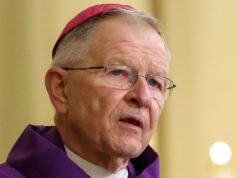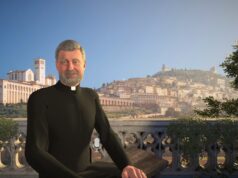
As the sky glowed a lurid orange from approaching wildfires, Stephen Morris knew what he had to do: pray — but not alone. Instead, the intrepid director of youth ministry for the Diocese of Santa Rosa, California, arranged a cross-country, around-the-clock perpetual Eucharistic adoration vigil to accompany displaced residents and other victims of the apocalyptic October 2017 Sonoma Complex Fires.
“Unless you’ve been in it, you don’t understand it,” Morris said. “The ominous sky — this foreboding, almost like end-of-times kind of reality — really gives you pause. … It felt very eerie.”
Santa Rosa Bishop Robert F. Vasa asked his flock to aid those suffering however they could.
“When you’re in that spot, what else do you have — besides staying close to loved ones, and recalling what’s most important in your life?” asked Morris, who rapidly coordinated the ongoing adoration.
“It was only due to some really honest and sincere relationships that I had formed throughout the country and locally that we were able to do anything,” Morris told OSV News. “The activity of prayer and remembrance was done with neighbors and with true friends, and that added to how special it was. We were praying for the firefighters and first responders. We were praying for people that lost everything.”
A special monstrance known as the Hope Monstrance — which survived a New Orleans Catholic church chapel flooded by Hurricane Katrina in August 2005 — was part of the prayer marathon. The monstrance, which had traveled to over 140 churches across Louisiana and Mississippi to bring hope to those communities and promote the power of perpetual adoration, was sent on tour in 2018 to three other communities hit hard by disasters, including Santa Rosa.
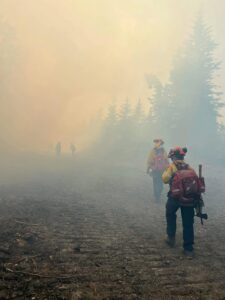
By the time the wildfires that started Oct. 8 were finally contained Oct. 31, they had destroyed 3,043 Santa Rosa homes, killed 22 of its residents, and caused billions of dollars in economic losses for the mid-sized city of almost 200,000.
While the cause was ultimately attributed to a homeowner’s faulty private electrical system, the Santa Rosa Press Democrat daily newspaper nonetheless declared: “In short, it was the fire that reset our notion of collective risk in the global climate crisis.”
What does a human-caused conflagration have to do with climate change? The answer lies in what literally became fuel for the fire.
As the National Oceanic and Atmospheric Administration explains, “Climate change, including increased heat, extended drought, and a thirsty atmosphere, has been a key driver in increasing the risk and extent of wildfires in the western United States during the last two decades. Wildfires require the alignment of a number of factors, including temperature, humidity, and the lack of moisture in fuels, such as trees, shrubs, grasses, and forest debris. All these factors have strong direct or indirect ties to climate variability and climate change.”
Climate change doesn’t start wildfires — but the drier conditions and warmer temperatures associated with it can create the conditions that make it easier for wildfires to start.
Pope Francis cautioned in his encyclical “Laudato Si‘” that “a very solid scientific consensus indicates that we are presently witnessing a disturbing warming of the climactic system. … If present trends continue, this century may well witness extraordinary climate change and an unprecedented destruction of ecosystems, with serious consequences for all of us.”
Glenn Juday agrees with the pontiff. The professor emeritus of forest ecology at the University of Alaska Fairbanks served as lead scientist trainer for the Catholic Climate Covenant formed in 2006 by the U.S. Conference of Catholic Bishops.
Since 1988, Juday has been a scientist in the Long Term Ecological Research Network — sponsored by the National Science Foundation — for the Bonanza Creek, Alaska, area, one of 28 such international sites. This ongoing study provides ecosystem data about conditions — and changes — over an extended period of time in the North American Boreal Forest, the largest intact forest left on earth, stretching across Canada.
“Fires that have been occurring and smoking up much of the continent of North America recently have been an explosion, almost unprecedented in our historical experience, of fires in the Boreal Forest,” Juday told OSV News.
“I actually began a program of focused research on climate change in variability in the late 1970s,” he said. The challenge was to define, “as scientists, a set of conditions that would convincingly demonstrate that the earth’s climate system and heat balance was higher than it used to be.” This “first detection” was accomplished in the 1980s.
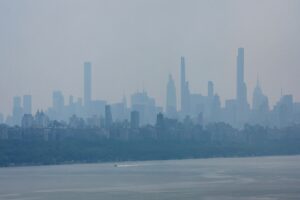
“Does it matter to ecosystems in a way that’s significant? The answer is yes,” Juday emphasized.
“Various scientists — applying the scientific method correctly — and reporting the results in peer reviewed literature so it’s open to scrutiny, and building open and accessible databases, have looked at these questions,” explained Juday. “And our answer is, yes, the warming climate has increased the severity, the frequency and the extent of fire in North American forest ecosystems, and it’s having ecosystem-level effects. It’s not the end of the world; the forest is not destroyed when it’s burned. But it’s changing. Our world is changing.”
Wildfires have always occurred, but landscapes — both soil and trees — are now often more thoroughly damaged, making it more difficult for them to regenerate. The concentration of greenhouse gasses in the atmosphere is also raised by wildfire activity.
In 2005, Juday acted as a field trip leader for a U.S. Senate committee. His task was to brief the visitors — including Democrat Hillary Clinton and Republicans John McCain, Lindsey Graham and Susan Collins — on the impact of climate change. Unsure of how he could tangibly demonstrate it to them, Juday found the wildfires did his work for him. “On the trip between Utqiagvik (Barrow) and Fairbanks — it was about an hour-and-45-minute flight in a 737 passenger jet — they were never able to see the ground because it was completely blanketed with smoke.”
In early June, when the skies of many East Coast cities dramatically reflected similar wildfire activity in Canada — and smoke turned the heavens orange in New York City and hazy over the monuments of Washington — Americans spared a thought for their neighbors to the north.
Among those battling the blazes was a priest — Father Gerald Mendoza.
Why would a priest — already pastoring two parishes, Our Lady of Assumption Parish in Chateh and St. Peter and St. Paul in Rainbow Lake, in Canada’s Alberta province — also become a volunteer firefighter?
“I am a Filipino,” said Father Mendoza. “It’s in our culture to work and work and work. We’re having an identity problem if we’re simply relaxing.”
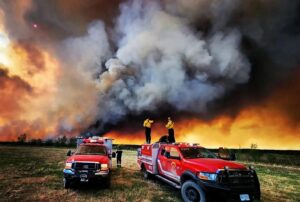
Father Mendoza has received fire alerts even while distributing Communion. Once forgetting to silence his text-announcing phone during Communion, both the priest and his parishioners learned at the same time of a grass wildfire. After Mass, Father Mendoza quickly doffed his vestments, rushed to the firehouse, changed into his firefighting gear, and took off to the scene of the inferno.
“There’s a need to watch, and to stand by,” explained Father Mendoza. Just as he is on call for his parishes, so he is for firefighting. “It’s a different mission, putting out fires.”
With one of the most aggressive wildfire seasons yet on record, more than 3.5 million acres — 69% of an average full Canadian wildfire season — burned in just seven days during late June, according to the Canadian Interagency Forest Fire Center.
“A few months ago, we received 103 wildfire alarms only in Alberta,” Father Mendoza said, “and that’s too much. … Summer is here — but hopefully, we’ll receive some rain. All of us are praying for rain here.”






